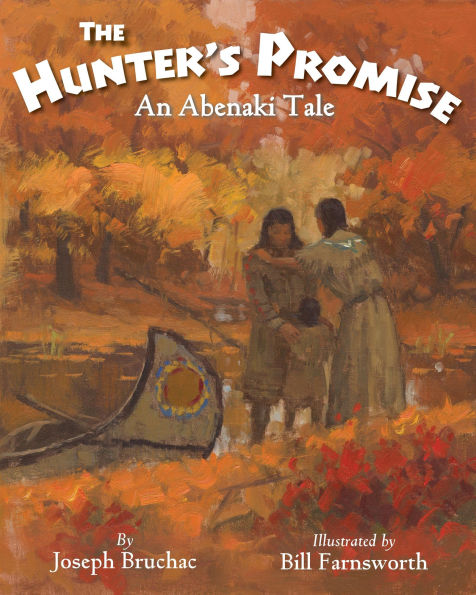Bruchac, Joseph. The Hunter’s Promise: An Abenaki Tale. Illustrated by Bill Farnsworth. Bloomington, Indiana: Wisdom Tales, 2015. ISBN 978-1-937786-43-4
Plot
“Long ago, in the forests of the northeast,” a young Abenaki man, spending his winter alone in the forest hunting, wishes for someone to share his life with. Shortly after making this wish, a young woman appears and begins caring for things around camp. When the hunter prepares to return to his village that spring, he promises that he will remember her. The hunter keeps his promise and returns to his camp the next fall, where he finds the woman and a young boy, his son, waiting for him. The following spring, the same promise is exchanged. But in the village that summer, the chief’s daughter decides she wants to marry the hunter, so her poohegan (spirit helper) clouds his memory. When the hunter and the chief’s daughter return to his camp that fall, the hunter sees his true wife and their sons waiting for him. He realizes the chief’s daughter has tricked him. His wife and two sons transform into moose and leave to travel deeper into the forest, the hunter deciding to join them.
Analysis
An author’s note at the beginning of the text gives readers a deeper look into the history and tradition of this tale, and words in the Abenaki language, such as sagamon (“chief”) and iawak mozak (“four moose”), are scattered throughout the book. Themes of trust, loyalty, and respect, both between family members and between humans and nature, are woven throughout this skillful retelling. The hunter demonstrated these qualities when he initially kept his promise to remember his wife, and again when he recognized the trickery of the chief’s daughter and left his human life behind to join his moose family at the end of the tale. Elements of mystery and magic, from the appearance of the young woman and the rapid growth of the hunter’s sons to the hunter’s magically clouded memory and ultimate transformation into a moose, give this tale the dreamy quality found in many traditional folk and fairy tales. The illustrations emphasize this quality with soft, often indistinct, oil paintings, while still clearly reflecting the heritage of this particular tale. Depictions of the hunter’s lodge and drying racks, canoe, and village will give unfamiliar readers a small glimpse into the historical lives of the Abenaki people. The illustrations also help mark the passage of time, with white, gray, and icy blue tones used for winter scenes, vibrant greens and blues used for summer, and warm reds and oranges used for fall.
Awards and Recognitions
The Hunter’s Promise has received much praise and recognition since its publication in 2015.
“The loyalty and thanks we owe our family and nature are embedded in this Native American cautionary tale. […] This fine fable brings a traditional indigenous story to a contemporary audience.”—Aimee Jodoin, Foreword Reviews
“The narrative itself is elliptical, offering literal readers a story of loyalty but founding it on a subtle exploration of the spirit world and its relation to ours. Bruchac and Farnsworth honor the Indians of the Northeast, the written versions of the tale, and the elders and Wabanaki tellers who keep this story alive.”—Kirkus Reviews
“Farnsworth’s handsome paintings depict a lush, light-infused wilderness, putting as much emphasis on the pristine setting as on the characters. The satisfying yet melancholy ending leaves a haunting impression.”—Publishers Weekly
Connections
The author’s note at the beginning of the book identifies other written retellings of this tale. In addition to reading these alternate retellings, consider reading some other retellings of Native American folklore, such as:
- Rabbit’s Snow Dance, retold by Joseph and James Bruchac and illustrated by Jeff Newman
- How Chipmunk Got His Stripes; Raccoon’s Last Race; and Turtle’s Race with Beaver, retold by Joseph and James Bruchac and illustrated by Jose Aruego and Ariane Dewey
- Tasunka: A Lakota Horse Legend, retold and illustrated by Donald F. Montileaux
- When Turtles Grew Feathers, retold by Tim Tingle and illustrated by Stacey Schuett
- The Owl and the Two Rabbits, retold by Nadia Sammurtok and illustrated by Marcus Cutler
Although The Hunter’s Promise gives readers a glimpse into the “long ago” lives of the Abenaki people, it does not give a complete picture. This book could serve as a jumping off point to learn more about Abenaki and other indigenous nations, both from a historical and a modern standpoint. The series Keepers of the Earth: Native American Stories and Environmental Activities for Children by Michael J. Caduto and Joseph Bruchac is one way to combine a love of stories and learning. Children may also enjoy acting out traditional Native stories with the help of Pushing up the Sky: Seven Native American Plays for Children by Joseph Bruchac and illustrated by Teresa Flavin.
*This review was written for a youth literature class through Texas Woman’s University.

No comments:
Post a Comment